TV3’s 3rd Degree show last night said they have ‘new’ evidence proving Robin Bain was the murderer, from tiny marks on 20 year old photos. I’m a professional photographer, and once an A grade competitive target shooter (full bore and .22), so I took an interest in the ‘new’ photographic evidence.
I think what was portrayed was VERY UNSAFE and doesn’t offer a ‘slam dunk’ to the case as claimed by some. I looked into it and can easily show the new evidence does not prove anything. I’ll show you why:
This was taken on film, printed to paper, scanned and presented here. It’s high contrast, has been through various reproductions already, was a crop of the original frame, and looks to have been sharpened to maximise it’s contents (this is a problem as I’ll explain).
I looked at my own hand and immediately saw I had two marks, which turned out to be exactly the same size as my .22 rimfire magazine. Hmm, interesting. I grabbed my iPhone and here is my quick shot taken on the couch during the programme:
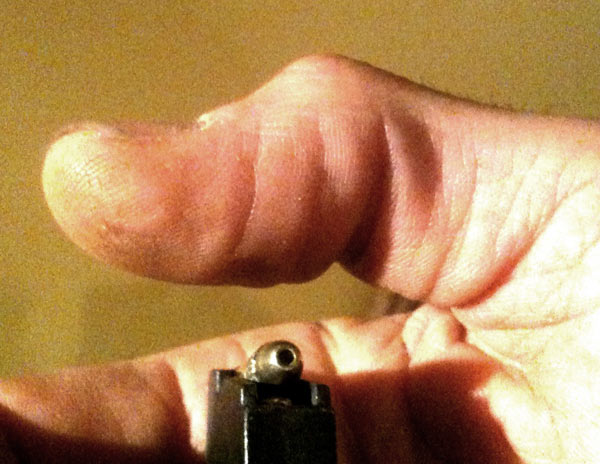
my first snap with my phone on the couch watching the 'new' evidence. Wow, I have two natural fold lines EXACTLY the same width of a .22 magazine too. Getting itneresting.
NOW I’m interested! How can it be so easy with a quick photo of someone else’s thumb (mine), get immediately into the ballpark of the new evidence? OK, let’s try with my Canon 1DsMk3 and 24-70 lens, and try to roughly copy the lighting (note the shadow direction – it will give very good relief to any folds or imperfections on Robin Bain’s skin from that side angle). Here’s the first go (quite difficult with camera angles and only 2 hands):
I then had a go at upping contrast,…
adding a bit of noise (to attempt to replicate film texture) and a bit of sharpening (sharpening is a bad thing for evidence – it works by increasing the edge contrast of artefacts and in the original photo will make fine lines, such as the evidence, darker and more soot like). Here’s what happened:
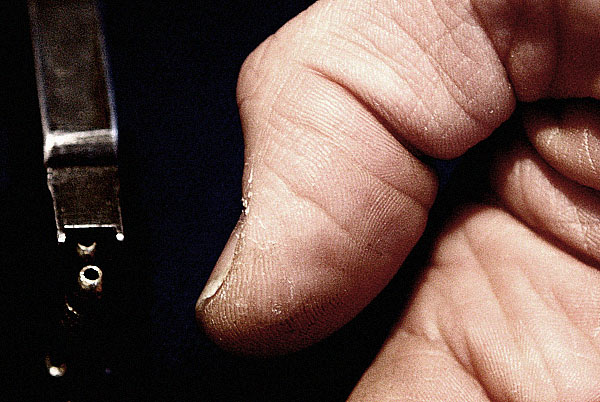
File with noise (film like texture), contrast increase (like film), and slight sharpening. Looking a bit more like the 'new' evidence
Then I added a bit more sharpening – such as would likely to have happened in the life of the original photo. Suddenly the folds in my hand start looking like soot!
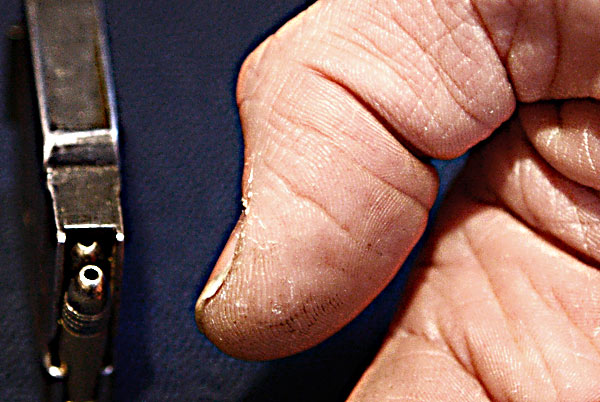
A bit more sharpening. Note that the two parallel marks on my thumb (while being different to Robin's hand but still similar) stay exactly the same as the other folds, just like Robin's hand. Soot would be much darker by now (which it isn't in the original - compare it to grease/dirt under his nails)
I then added a slight lens blur trying to replicate the softness of the original evidence photo. This seems to have made the folds stand out even more as soot!
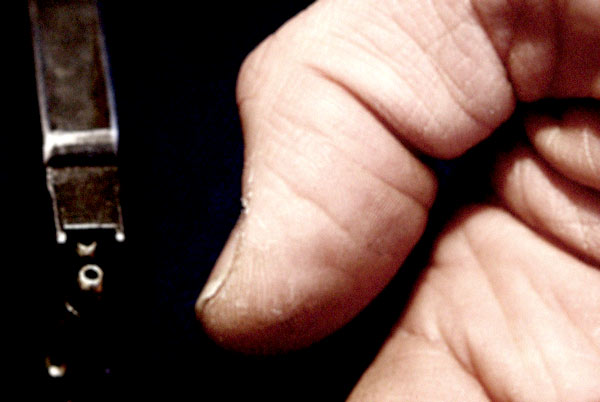
Used lens blur to soften the image to a similar grade as the original. It makes the marks stand out more.
Next I wondered what would soot look like on the original photo. I took a RGB reading from the closest thing on the frame, and that’s the dirt/grease under Robin’s fingernail. It’s about 3/4 black (dark grey). I added that to the thumb amd immediately it’s clear that the so called soot marks are way too light. They’re the same tone (brightness) as the other folds in his hand under the same light. Ok, lets add pure plack to the same frame for reference. Nope, that only makes it clearer that those lines don’t have the tonal density to be soot relative to the skin folds on his hand.

Then selected a soot like tone (from the fingernail dirt/grease) and wiped some onto the thumb. This is a middle dark grey, not black (as soot would be). It looks to me that the two marks being claimed as soot aren't. The marks have the same tone as other folds on his hand. It clearly shows me we're not dealing with soot here. A pure black is added for reference.
OK, so my quick attempt is not a perfect copy of the original, but this only serves to reinforce how easy it is to get a completely different outcome from that proposed on TV. It clearly shows that the original photo does not confirm soot marks from a magazine. But wait there is more. Matters which in my mind make it unlikely to confirm that Robin Bain loaded the magazine are:
1) the so called soot marks are exactly the same contrast as other folds in his hand (especially the right one), soot would be much darker than the grit in the side of the finger nails;
2) Photoshop eyedropper RGB spot analysis of the left mark indicates a much larger proportion of red in it’s RGB profile (RGB:149:98:95), while the one on the right has a more neutral mix (RGB:185:141:142). It indicates to me that the left hand mark is probably a scab or cut as soot would not have a red component. It’s RGB values are different enough to tell me that they are completely unrelated. This is now the most compelling point for me as to why these aren’t magazine soot marks, and the ‘new’ evidence is totally flawed;
3) his hands have been doing manual labour and he has dirt, scratches and cuts elsewhere, so it’s not unlikely that one of these marks is a cut;
4) manual labour accentuates folds in the skin (as it has on my hands from cutting gorse and chainsawing yesterday);
5) the light angle present will accentuate any natural folds in the skin of his thumb (e.g. casting a shadow);
6) I practised loading a magazine in as many different ways I could. It was very awkward to load parallel to the lines of those in the original shot, which further diminishes my belief the ‘new’ evidence is likely.
Therefore, I don’t think this is reliable evidence. As a professional photographer I know how light angles can create and remove artefacts that may or may not exist. I think this is simply a conincidence at best (heck, I didn’t even use Robin Bain’s hand to show it, just a random one (mine), and could certainly not be relied on. My feeling is that the right hand mark is a natural skin fold shadow, and the left one is an old healing cut, like the others he has.
A TV film crew created a fantastic scenario that the marks were made by a rifle magazine. I’ve shown that they were created by a camera. It’s not enough to say Robin Bain did it.
Thanks for the feedback on hand moisturiser by the way. I’d just had 3 hours on the chainsaw and fore went vanity for preciseness!
What do you think?
Update: @gregfranksimmo via twitter suggests that my thumb is bent while the body was relaxed. Very good point. I just tried it straight and relaxed, and against expectation, it actually makes the folds more like the ones in the original photo – shorter and more defined.
Footnote: Police have since responded in the media. Their story certainly fits with my view that the marks are either folds or cuts – pretty clear from that thumb print I think.














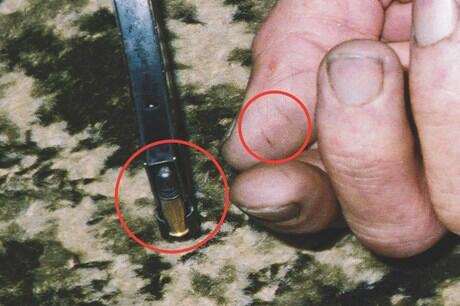
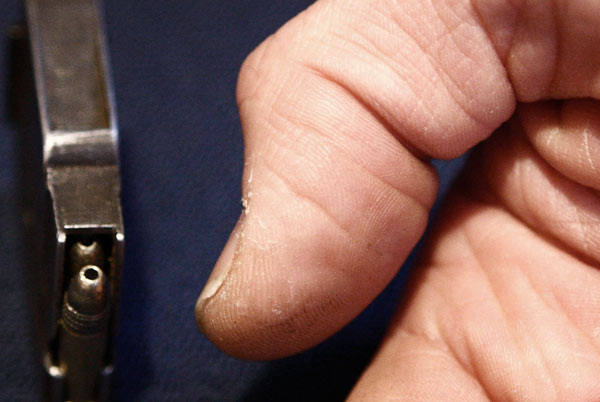
Excellent post Rob; have linked to it at my blog.
Rob
I too tried loading a .22 mag in different ways and found it quite an awkward manner to produce the parallel indentations across the thumb. My natural loading action formed parallel indentations down the thumb from the top of it. As I loaded more rounds I ended up with several lines of indentations.
The gun smith in the TV item measured the distance between the two marks on RCB’s thumb at 17.5mm and then measured the width of a .22 mag getting an identical measurement. The metric conversion of the .22 is 5.5mm and the distance between the outer edges of the casing rails on my mag that left the indentations/residue lines measured out just under 8mm. I am wondering how a .22 mag with a width of 17.5mm could hold any rounds.
How accurate can a measurement be made from a photograph that does not have a scale in it?
Further, another expert on the TV “show” made a similar comparison using his computer programme to place the same size line between the thumb marks and the edges of the magazine.
Again how accurate is this exercise on a photograph where the two subjects being compared are not in the same plane?
Enjoyed your post…thanks
Thanks for that presentation. Always good to read someone who knows what they are talking about.
Excellent stuff thanks Rob, especially the RGB analysis. Frankly, TV# needs to be taken to task for such biased reporting.
Best wishes
To me your photographic analysis is as relevant, if not more relevant, than the firearm experts in the TV3 show. The RGB analysis is interesting. Thanks
How wide is a finger? ~15mm the distance between the marks is much less than a finger width… are you sure he said 17.5mm?
Ronl
I have gone to replay TV to have a look at the other nights programme. The gunsmith actually compared the 17.5mm measurement to the width of the mag in the same photo, not to the demonstration mag as I had thought. My mistake. It appears that he takes his measurement from the widest edge of the mag not from the tapered sides that produce these parallel lines. My money is on there not being a match in the two widths when a proper analysis is done.
I agree Rob….and the Press today had a great article by Martin van Beynen who nicely dissected the so called game changer.
I still think the James McNeish book is the most unemotional look at this case, which sadly has just become a media battle for so long now.
Thanks, Paul.
I have linked to this from our site: http://davidbain.counterspin.co.nz/news/photo-analysis-shows-that-marks-on-the-thumb-can-be-easily-made-and-are-not-necessarily-gun-residue
An excellent analysis.
Karam’s slam-dunk smokescreen about powder residue detracts from the often overlooked contention that Robin’s hand(s) would have been covered in blood if he had manipulated the rifle in the awkward manner they would have us believe necessary to shoot himself.
If those marks on thumb and finger are actually scratches it is quite possible they were made by the cutters on the chainsaw chain during the week(s) prior to the murders. I have experienced similar marks or scratches on thumb and forefinger while advancing the chain by hand during oiling or sharpening.
Pity Police didn’t front up a spokesman like Burgess right at the start of all Karam’s ranting.